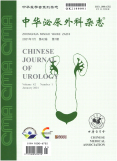PI-RADS评分>3分患者前列腺初次活检漏诊风险及其危险因素分析
Analysis of missed diagnosis and risk factors in patients with negative initial prostate biopsy with PI-RADS score>3
摘要目的:分析前列腺影像报告和数据系统(PI-RADS)评分>3分而前列腺初次活检阴性患者的漏诊风险并探讨其危险因素。方法:回顾性分析2013年5月至2018年12月江苏省苏北人民医院268例前列腺初次活检阴性患者的临床资料,按照不同PI-RADS评分分为观察组(PI-RADS>3分)和对照组(PI-RADS≤3分)。观察组124例,对照组144例,两组年龄[67.4(60.0,74.0)岁与65.6(66.5,72.0)岁]、初次活检前列腺体积[62.4(40.0,72.0)ml与60.8(38.0,77.0)ml]、活检针数[20.6(18.0,22.0)针与20.4(18.0,22.0)针]差异均无统计学意义( P>0.05);观察组与对照组前列腺特异性抗原(PSA)[17.5(6.5,23.0)ng/ml与11.5(6.3,12.0)ng/ml]、PSA密度[0.316(0.128,0.363)ng/ml 2与0.211(0.106,0.256)ng/ml 2]、初次活检病理为前列腺炎比例[56.5%(70/124)与22.2%(32/144)]的差异均有统计学意义( P<0.05)。根据初次活检后随访结果比较两组重复活检情况;利用单因素和多因素logistic回归分析PI-RADS>3分患者重复活检阳性的危险因素,绘制受试者工作特征(ROC)曲线,分析其危险因素的准确性。 结果:观察组与对照组的重复活检率[27.4%(34/124)与14.6%(21/144)]、有临床意义前列腺癌(CsPCa)检出率[41.4%(14/34)与4.8%(1/21)]的差异均有统计学意义( P<0.05)。观察组与对照组重复活检阳性率的差异无统计学意义[41.1%(14/34)与23.8%(5/21), P=0.248];观察组重复活检阳性的风险是对照组的2.24倍。单因素分析结果显示重复活检PSA( P=0.02, OR=1.438,95% CI 1.161~1.896)、重复活检PSA与初次活检PSA的比值(PSA比)( P=0.011, OR=10.087,95% CI 1.714~59.36)是PI-RADS评分>3分患者重复活检阳性的危险因素;多因素分析结果显示重复活检PSA( P=0.017, OR=1.15,95% CI 1.076~2.123)、PSA比( P=0.032, OR=10.2,95% CI 0.883~116.168)是重复活检阳性的危险因素。ROC曲线分析结果示,重复活检PSA(AUC=0.971, P<0.001,95% CI 0.926~1.000)、PSA比(AUC=0.839, P=0.001,95% CI 0.707~0.971)对患者重复活检阳性的预测有较高的准确性,截断值分别为21.3 ng/ml和1.4;重复活检PSA和PSA比联合预测的准确性进一步提高(AUC=0.993, P<0.001,95% CI 0.974~1.000)。 结论:与PI-RADS评分≤3分患者相比,PI-RADS评分>3分且初次活检阴性患者漏诊CsPCa的风险较大,随访过程中PSA>21.3 ng/ml、PSA比>1.4时,初次活检漏诊的可能性大。
更多相关知识
abstractsObjective:To analyze the risk of missed diagnosis in patients with PI-RADS score>3 and negative prostate initial biopsy and to explore its risk factors.Methods:The clinical data of 268 patients with negative prostate biopsy in Northern Jiangsu People's Hospital from May 2013 to December 2018 were retrospectively analyzed. The patients were divided into observation group (PI-RADS score>3) and control group (PI-RADS score≤ 3) according to different PI-RADS scores. There were insignificant differences in age [(67.4(60.0, 74.0)years and 65.6(66.5, 72.0)years], prostate volume of initial biopsy [62.4(40.0, 72.0)ml and 60.8(38.0, 77.0)ml], biopsy cores [ 20.6(18.0, 22.0)cores and 20.4(18.0, 22.0)cores] between the observation group (n=124) and the control group(n=144)(all P>0.05). But there were significant differences in PSA [17.5(6.5, 23.0)ng/ml and 11.5(6.3, 12.0)ng/ml], PSAD[0.316(0.128, 0.363)ng/ml 2 and 0.211(0.106, 0.256)ng/ml 2], prostate inflammation of the initial biopsy [70 (56.5%) and 32 (22.2%)] between the observation group and the control group(all P<0.05). According to the follow-up results after the initial biopsy, the two groups of repeated biopsy were compared.Furthermore, Logistic regression was used to conduct univariate and multivariate analysis to explore the risk factors of patients with PI-RADS>3 for positive repeated biopsy. At the same time, the receiver operating characteristic curve (ROC curve) was used to analyze the accuracy of the risk factors. Results:There were significant differences in repeated biopsy rate [ 27.4%(34/124)and 14.6%(21/144)], CsPCa detection rate[ 41.4%(14/34) and 4.8%(1/21)]between the observation group and the control group(all P<0.05). The positive rate of repeated biopsy in the observation group (41.1%) was higher than that in the control group (23.8%), but there was no statistical difference ( P=0.248). The risk of positive repeated biopsies in the observation group was 2.24 times than that in the control group. Univariate analysis found repeated biopsy PSA ( P =0.02, OR=1.438, 95% CI 1.161-1.896), PSA ratio (repeated biopsy PSA/initial biopsy PSA) ( P=0.011, OR=10.087, 95% CI 1.714-59.36) were risk factors for positive of repeated biopsy in patients with PI-RADS score >3. Multivariate analysis also found that repeated biopsy PSA ( P=0.017, OR=1.15, 95% CI 1.076-2.123), PSA ratio ( P=0.032, OR=10.2, 95% CI 0.883-116.168) were risk factors for positive repeated biopsy. ROC curve analysis, the accuracy of repeated biopsy PSA (AUC=0.971, P<0.001, 95% CI 0.926-1.000), PSA ratio (AUC=0.839, P=0.001, 95% CI0.707-0.971) to predict positive of repeated biopsy were high. The cut-off values were 21.3 ng/ml and 1.4, respectively. The accuracy was higher when combines repeated biopsy PSA with PSA ratio (AUC=0.993, P<0.001, 95% CI 0.974-1.000). Conclusions:Patients with negative PI-RADS score > 3 have a higher risk of missed diagnosis of CsPCa than those with PI-RADS score≤3. When PSA>21.3 ng/ml and PSA ratio>1.4 during follow-up, the possibility of missed diagnosis in the initial biopsy is high.
More相关知识
- 浏览1818
- 被引5
- 下载138


相似文献
- 中文期刊
- 外文期刊
- 学位论文
- 会议论文



 换一批
换一批 换一批
换一批



